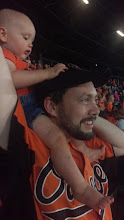 Well, it was nice while it lasted. From Thursday through Sunday, the Orioles crafted their longest winning streak yet this season, a whopping four games. It was especially encouraging to see the offensively-challenged O's rally from deficits of 3-0, 6-0, 5-0, and 3-0 again to put those contests in the win column. But during last night’s back-to-reality, 4-2 loss against Oakland, MLB.com beat reporter Britt Ghiroli quoted a disturbing statistic. So far in 2010, the Orioles are 0-46 when trailing after eight innings. No matter what the margin, they’ve been unable to overcome it. Among the many things that O’s fans have been denied this season, they’ve yet to be treated to the exquisite relief and euphoria of a probable defeat turned on its head into a sudden victory.
Well, it was nice while it lasted. From Thursday through Sunday, the Orioles crafted their longest winning streak yet this season, a whopping four games. It was especially encouraging to see the offensively-challenged O's rally from deficits of 3-0, 6-0, 5-0, and 3-0 again to put those contests in the win column. But during last night’s back-to-reality, 4-2 loss against Oakland, MLB.com beat reporter Britt Ghiroli quoted a disturbing statistic. So far in 2010, the Orioles are 0-46 when trailing after eight innings. No matter what the margin, they’ve been unable to overcome it. Among the many things that O’s fans have been denied this season, they’ve yet to be treated to the exquisite relief and euphoria of a probable defeat turned on its head into a sudden victory.Few ninth-inning comebacks in recent Birds history have been as dramatic as the one delivered by Chris Hoiles on May 17, 1996. It was a Friday night game vs. the Mariners at Oriole Park at Camden Yards, and it had been a back-and-forth, high-scoring affair, as was the M.O. for the '96 O's. The home team bombarded Seattle starter Bob Wolcott, with 11 of 18 batters reaching base against him. Young Orioles starter Jimmy Haynes survived five shaky innings of his own (8 H, 3 BB), but left with a 7-2 lead. The first man in from the 'pen was Arthur Rhodes, who did not retire any of the four batters he faced. All of them came around to score, with a little help by way of throwing errors by Roberto Alomar and B. J. Surhoff. Roger McDowell stopped the bleeding, but it was a whole new game at 7-6.
The Birds got some breathing room via a Rafael Palmeiro two-run home run in the home half of the seventh, making it 9-6. When Seattle threatened again in the eighth, Davey Johnson started playing bullpen roulette and busted. McDowell left with a run in, two on, and one out. Jesse Orosco retired the only batter he faced (Luis Sojo), leaving one more out to be collected by Alan Mills. Mills got that out, but first he walked pinch hitter Brian Hunter to load the bases and allowed an Alex Rodriguez grand slam to un-load them. 11-9 Mariners.
Cal Ripken, Jr. halved the deficit with a solo homer off of Mike Jackson, but Mills continued his Gasoline Man act in the ninth, with a two-run shot by Jay Buhner giving the M's and closer Norm Charlton a 13-10 cushion heading into the bottom of the ninth. That's when things really got wild.
Alomar led off with a walk, but Charlton got Palmeiro to strike out. A Bobby Bonilla double brought the tying run to the plate, but pinch hitter Billy Ripken (stop laughing) fouled out to first base and the Orioles were down to their last out. Cal picked up his little brother by coaxing a walk to load the bases, which placed the burden squarely on the shoulders of Chris Hoiles. The tension built as the veteran catcher worked the count full. Now the Birds were down to their last strike...the pitch was delivered by Charlton...
GRAND SLAM! ORIOLES WIN, 14-13!
What Hoiles did on that night is one of the rarest of baseball feats, the "ultimate grand slam": a walkoff bases-loaded homer that allows the home team to win by a single run. Only 22 other players in major league history have done it, but Chris was the only one to pull it off with two outs and a full count, causing some to dub his clout the "Ultimate Ultimate Grand Slam". Not a bad feather to put in your cap.






























